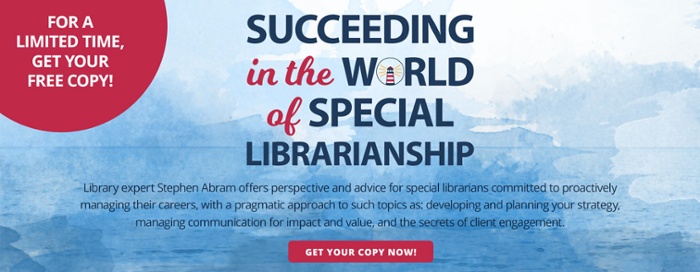
As special librarians, we connect clients to information and data. Our struggle is influencing the overall process of knowledge creation and the best behaviors for successful decision-making.
We can address some of these transformational activities with training, consultation, and more classroom and interpersonal research and team work. The value-added that I’ve focused on in my series of posts on “aligning research results with decision making” is in the formation of our work product so that it aligns more closely with the ways in which the user thinks, behaves, and uses the information and data we provide.
Let’s summarize this series about aligning your research results with decision-making.
Just a reminder, here are the links to this series:
- Part One: Aligning Research Results with Decision-Making—SWOT, 4-Squares, Fish Bones, and More
- Part Two: Aligning Research Results with Decision-Making—Thinking About Thinking (Edward de Bono)
- Part Three: Aligning Research Results with Decision-Making—Tools to Inspire Creativity and Encourage Divergent Thinking
- Part Four: Aligning Research Results with Decision-Making—SWOT and Fish Bones
- Part Five: Aligning Research Results with Decision-Making—Mind Mapping and Boxes
In these Think Clearly blog posts, we’ve reviewed at a high level:
- Six Thinking Hats
- Six Action Shoes
- SWOT
- Fish Bone Force Field Analysis
- Diverge / Converge
- Post-its
- Dot-ocracy (or Dot-Storming)
- Mind Mapping
- Boxes and the BCG Matrix
Help me understand…
I believe that one of our best and most important professional skills is improving the quality of the question. We can do that in many ways but basically the core competency is the reference interview which improves over time with the practice of librarianship.
Excitingly, while improving the core skill of reference interviewing (negotiation, if I may), it doesn’t extend far enough. We’re seeing threats and opportunities in AI and machine learning as they start to nip away again at the question space – indeed as Google did years ago.
To be successful now, we have to focus on adding value in a myriad of ways.
In reading about the common tools used by decision-makers (and consultants) to focus people on the decisions at hand, I see opportunities for frameworks to add value that meets one of Ranganathan’s key principles, “Save the time of the reader.”
It’s not enough just to focus on off-loading research tasks to our fine selves. We need to be aware of how our clients think and adapt information. A focus on reading isn’t enough. Lord knows that most of our folks are professionals at their field and they scan and review more than they read deeply. Providing entry points and improving scannability is one small step. And that’s where all those tools like Post-It™ notes/tabs/arrows, Highlighters, rubber stamps, and coloured pens and markers come in.
In the advanced class we can provide, through our own use or on our intranets, summarization tools, bibliographies and webliographies, current awareness sites and tools, and transformative tools like spreadsheet ready downloads or citation tools.
These are all awesome, but are they enough to improve the path to insight, use and decision?
Sometimes we struggle as special librarians on the right level of value-added to deliver and effort/return ratio.
So, how do we align research results with client need?
T’was ever thus: our clients rarely care about the format of the information – articles, blog posts, internal archives and records, news features, video, gossip, tweets, etc. If it has a nugget of good info (perhaps the only source), then it’s in. That said, our intranets are often organized by format. That’s a big misalignment. Broadcast or federated search goes a way to fixing this but it still doesn’t add the value a great special librarian can provide.
Put on a new lens.
- Think about adding value by focusing on the decision your client will be making.
- Think about adding value by creating a ‘map’ to the information. Information seeking patterns and exploration are messy. A map through the space ads value.
- Use the tools described in the other posts in this series. Learn more about them and see how they might provide frameworks for reading, decision-making, exploration and insight discovery.
- Show your own thinking. Take a risk and offer a professional opinion on the best, clearest or most compelling content.
- Make it tangible. Sign your work. Share your process, lenses, and frames.
- Follow through and improve your packaging of the research results. Adding value is a journey – not a mere task.
- Can any of these frameworks turn into new ways to create bibliographies, webliographies, or LibGuides?
- Ultimately share your learning (as I’ve done in this series) about ways to improve the speed from access to insight to decision.
We all improve with practice.
-Stephen
Stephen Abram is a popular Lucidea Webinars presenter and consultant. He is the past president of SLA, and the Canadian and Ontario Library Associations. He is the CEO of Lighthouse Consulting and the executive director of the Federation of Ontario Public Libraries. He also blogs personally at Stephen’s Lighthouse. Check out his new book from Lucidea Press, Succeeding in the world of Special Librarianship!



